Formed Unknown Dissipated 5 March 1899 | Highest winds 205 km/h | |
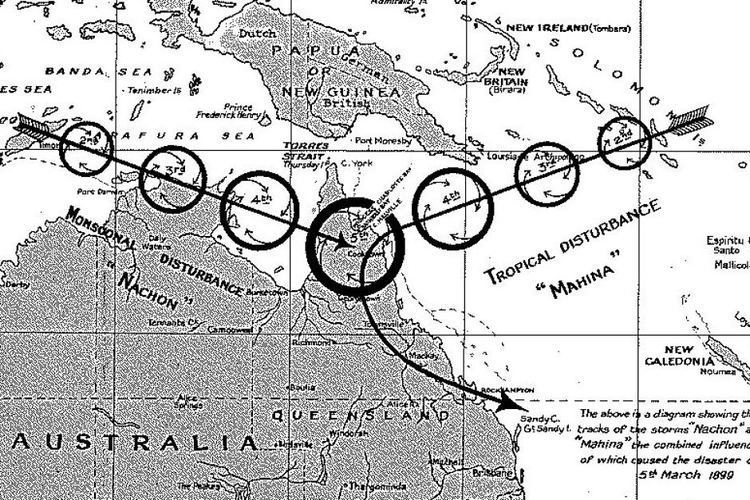 | ||
Fatalities Over 300, possibly up to 410 (see casualties) Similar Cyclone Joan, Cyclone Ingrid, Cyclone Larry, Cyclone Orson, Cyclone Justin | ||
Cyclone mahina
Cyclone Mahina is the deadliest cyclone in recorded Australian history. It struck Bathurst Bay, Cape York, on 4 March 1899, and its winds and storm surge combined to kill more than 300 people.
Contents
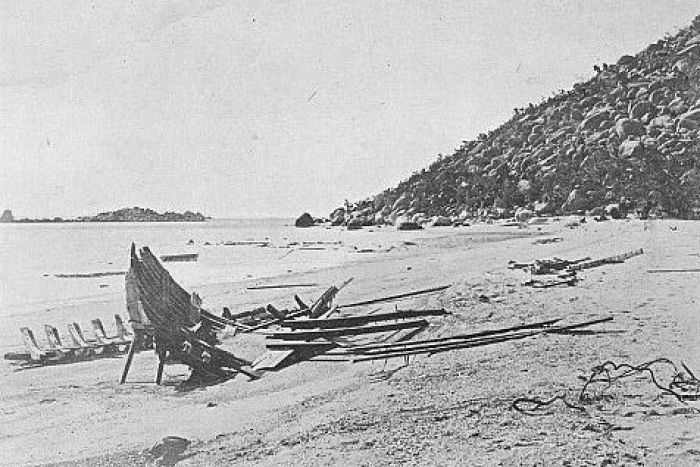
The World Meteorological Organisation is currently considering an application from Queensland scientists and researchers to have the Mahina's intensity upgraded to 880 hectopascals. This would make it the most intense cyclone recorded to have hit the Australian mainland.
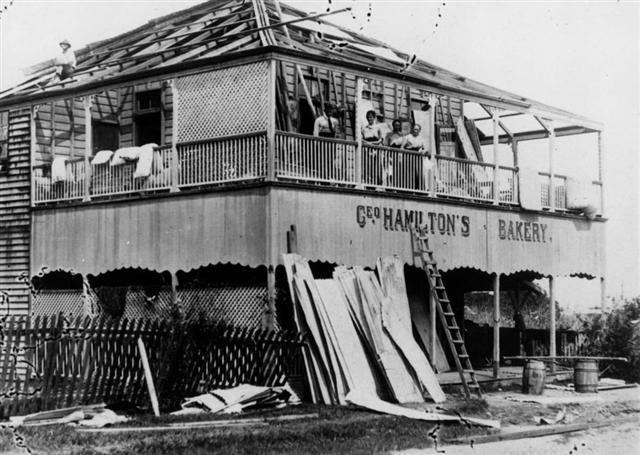
Intensity
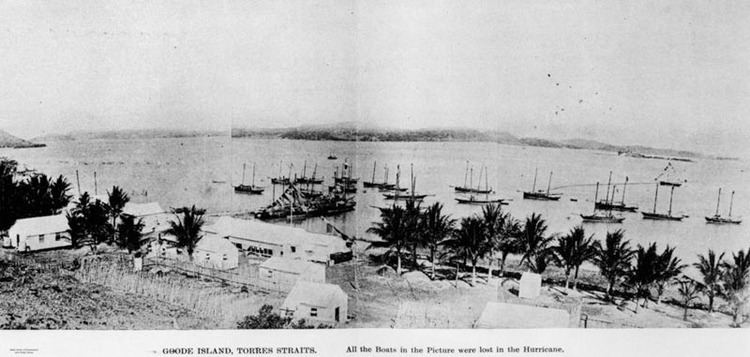
Tropical cyclone Mahina hit on 4 March 1899. It ranks as a Category 5 cyclone, the most powerful of the tropical cyclone severity categories. In addition, Mahina perhaps ranks among the most intense cyclones ever observed in the Southern Hemisphere and almost certainly as the most intense cyclone ever observed off the Eastern states of Australia in recorded history. Clement Lindley Wragge, Government Meteorologist for Queensland pioneered naming of such storms and gave this storm its name, Mahina.

Such storms occur extremely rarely. Scientists identified two other category-4 or 5 super-cyclones in the first half of the 19th century from their effects on the Great Barrier Reef and the Gulf of Carpentaria. This same research shows that on average, such super-cyclones occur in the region only once every two or three centuries.
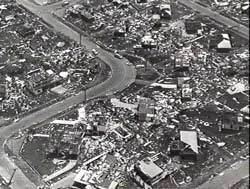
Contemporary reports vary considerably in the reported lowest barometric pressures. The pressure recorded on the schooner Olive reasonably consistently show her lowest pressure recorded: 29.60 inches of mercury (100.2 kPa) to 29.10 inches of mercury (98.5 kPa) or between 29.00 inches of mercury (98.2 kPa) and 29.10 inches of mercury (98.5 kPa). In a further variant, "during the lull in the hurricane, the barometer on the Olive recorded" 29.70 inches of mercury (100.6 kPa) to 29.10 inches of mercury (98.5 kPa).

Most sources record the schooner Crest of the Wave observation as 27 inches of mercury (91 kPa) More modern reports of an 18-inch observation on a vessel in the eye of Mahina seemingly lack relationship to contemporary records.
One author accepted the 29.1 inches of mercury (99 kPa) report from the Olive and the 27 inches of mercury (91 kPa) report from the Crest of the Wave, seemingly unaware of the discrepant reports. He estimated the track of the cyclone from the damage reports, placing it directly over the position of the Crest of the Wave. The Olive to the north missed the centre. The separation between these schooners explains the difference between their respective pressure measurements. He calculates the centre pressure, standardised for temperature, as 914 hectopascals (13.26 psi).
A study in 2014 found the lowest pressure perhaps around 880 hectopascals (12.8 psi), based upon modeling of meteorological variables needed to induce the potentially world-record-setting surge height of 13 metres (43 ft). This surge closely matches new evidence on storm depositions and accounts actually reported to two other captains and in a letter to his parents a reading of 26 inches of mercury (880 hPa). This study considers the apparently third-hand report of 27 inches of mercury (910 hPa) a not necessarily reliable measurement perhaps made five hours prior to passage of the eye.
In comparison, the tiny Cyclone Tracy devastated Darwin in 1974 with a central pressure of 950 hectopascals (13.8 psi). Barometric pressure this low at mean sea level also likely caused cyclone Mahina to create such an intense, phenomenal, claimed world-record storm surge not thereafter known.
Impact
A pearling fleet, based at Thursday Island, Queensland, anchored in or near the bay before the storm. Within an hour, the storm drove much of the fleet ashore or onto the Great Barrier Reef; other vessels sank at their anchorages. Four schooners and the manned Channel Rock lightship were lost. A further two schooners were wrecked but later re-floated. The fleets lost 54 luggers, and a further 12 were wrecked but re-floated. People later rescued more than 30 survivors of the wrecked vessels from the shore; however, the storm killed more than 400 people, mostly non-European immigrant crew members. a depiction of the Crest of the Wave in the storm can be seen here.
A storm surge, reportedly 13 metres (43 ft), swept across Princess Charlotte Bay and then inland about 5 kilometres (3.1 mi), destroying anything left of the Bathurst Bay pearling fleet and the settlement.
An eyewitness, constable J. M. Kenny, reported that a 48-foot (15 m) storm surge swept over their camp at Barrow Point atop a 40-foot (12 m)-high ridge and reached 3 miles (4.8 km) inland, the largest storm surge ever recorded. However, reviewing the evidence for this surge, some scientists based on the 914-hectopascal (13.26 psi) central pressure, modeled a surge should only be 2 metres (6 ft 7 in) to 3 metres (9.8 ft) in height. They also surveyed the area, seeking wave-cut escarpments and deposits characteristic of storm events but found none higher than 5 metres (16 ft). Of the 48-foot (15 m) surge, they suggest an incorrectly cited ground level or an involvement of freshwater (rain) flooding. A subsequent study considers this conclusion possibly premature and questions the barometer reading as considered unreliable and as not representative of the lowest pressure. This subsequent study also examined new evidence of exceptionally high storm surge and inundation.
The cyclone continued southwest over Cape York Peninsula, emerging over the Gulf of Carpentaria before doubling back and dissipating on 10 March.
Casualties
The exact number of casualties is not known as many deaths were not recorded. Estimates range between 307 and 410.
In September 1899, the Queensland Marine Department published a list of 247 known fatalities. The Queensland Registry of Births, Deaths and Marriages has 283 registered deaths attributed to the cyclone, including 250 on pearling ships. One of the pearling fleet owners estimated another 30 people not officially registered as crew were killed and not reported to the Cooktown Registrar.
Around 100 Indigenous Australians were killed but not recorded as Indigenous people were not counted as part of the population at the time. They had tried to help shipwrecked men, but the back surge caught them and swept them into the sea. Only eight Indigenous people were recorded amongst the casualties, all of whom died on shore.
The Queensland Historical Atlas reports the death toll as "307 pearl divers and sailors and an unreported number of Aborigines".
Aftermath
People found thousands of fish and some sharks and dolphins several kilometres (miles) inland, and the storm embedded rocks in trees. On Flinders Island (Queensland), people found dolphins on the 15.2-metre (50 ft) cliffs; however, this finding need not indicate a surge of this height; on this exposed site, wave run-up readily can produce these results even within the more modest calculated surge.
At Cape Melville, survivors erected a memorial stone to "The Pearlers" lost to the cyclone, naming 11 Europeans but only citing "over 300 coloured men" for the other seamen. The Anglican church on Thursday Island, Queensland, also commemorates this disaster.
